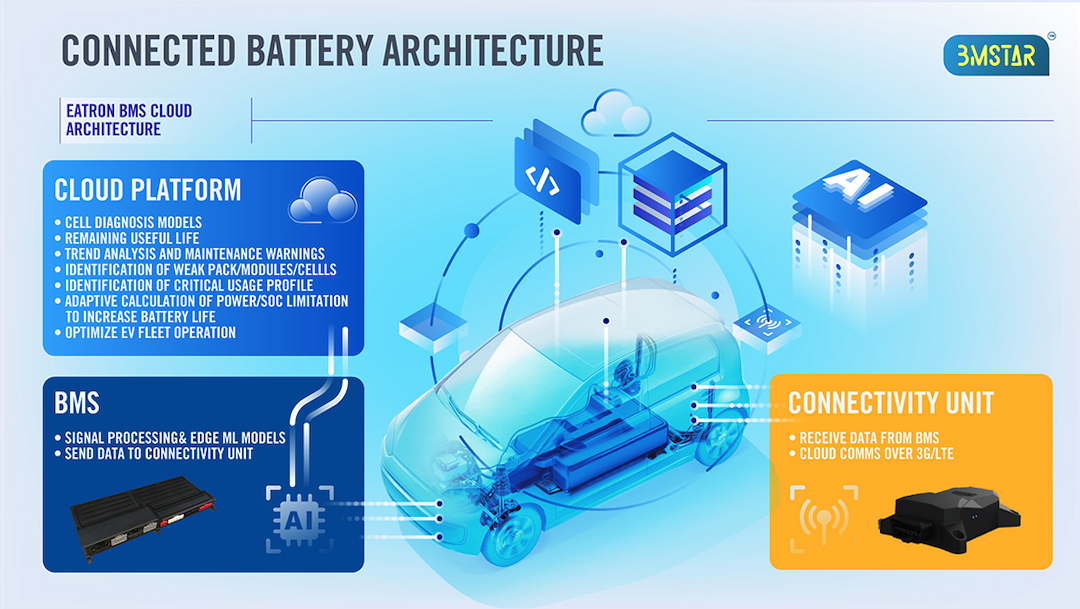Enhanced artificial intelligence is an enabler for greater battery durability, energy density and charging speed. Eatron Technologies experts explain.
After two decades of significant advances in electric vehicle (EV) battery development, innovations continue to bring promises of greater battery performance, safety, faster charging, longevity and durability. One area of fresh thinking concerns battery management systems (BMS) using artificial intelligence (AI) as an enabler. Or more specifically, a novel dimension of AI, according to Dr. Umut Genc, managing director of Eatron Technologies, a U.K.-based company specializing in intelligent software for electric and autonomous vehicles.
“We define [it] as physics-based modeling with selective AI,” he said. “It is vital to understand AI’s limitations. First, the amount of memory and processing power required by an AI system is substantial, increasing cost and energy consumption. Second, AI is still in the early stages of application, so it is often seen to be not without risks. Any mission-critical system that is solely dependent on AI is currently difficult to validate to automotive standards,” Genc explained.
The solution, he noted, is the same for both challenges, starting with understanding the value that AI brings to objectives. Eatron’s technical director, Can Kurtulus, underlined the importance of OEMs recognizing that there will not be a huge step in battery chemistry for some time. Therefore, many improvements in durability, usable energy density and charging speed must come from improved battery management.
Kurtulus said he believes the key to be the application of physics-based software – control systems with embedded system models. This is a control technique in which look-up tables are replaced by an embedded software model of the system.
“In other areas of vehicle design, accurate digital simulations have helped to eliminate the need for over-engineering. This has brought down cost and weight in a ‘virtuous circle,’” he said. “Our approach to BMS is similar, except we will be embedding the model in the control system of every battery pack and applying it in real time throughout the vehicle’s life, not just during the design stage, so rather more than regular AI technology.”
First for EV diagnostics
With the backing of an unnamed German Tier 1 supplier and engineering teams in the U.K. and Turkey, Eatron’s initial production programs concerned chassis management systems and SAE Level 2 automated driver-assist systems. But BMS has now become a major R&D program. The immediate benefits claimed for Eatron’s selective AI applications are the reduced need to over-specify the battery to protect durability and hence lower warranty costs.
“The biggest influences on battery life are currently the state of charge window: how close to full charge and full discharge the battery is allowed to go, and then the rate of charge,” Kurtulus said. “So, in today’s production systems, warranty claims are minimized by calibrating the BMS to prevent the battery being charged to full capacity, to never approach deep discharge even if the vehicle is only a few miles from a charging station, and to always restrict the fast-charge capability.”
An Eatron innovation is to use its physics-based modeling techniques to predict the remaining useful life (RUL) of the battery. The company expects to be the first supplier of production technologies offering this feature for lithium-ion EV batteries. It also aims to be first to offer vehicle OEMs an opportunity to include a RUL indicator in the vehicle diagnostics.
Genc noted selective AI’s major benefits will be fully gained when the BMS is connected to the cloud. “Prediction of the RUL will allow the vehicle manufacturer to issue over-the-air calibration updates that maximize customer benefits, such as fast charging and range,” he noted, “while remaining confident that warranty and durability targets will be met.”
As more data is analyzed, the AI learns; predictions become more accurate and the benefits are automatically incorporated in the decision-making. There is also potential for the vehicle OEM to add new features that bring additional benefits for owners. For example, there is currently no way for a used vehicle buyer to determine the RUL of an EV’s battery.
“For fleets especially, an ability to manage and then validate the RUL will add significant value when they come to dispose of their vehicles. A dashboard RUL indicator could be fitted,” Genc stated. Added Eatron’s business development director, Amedeo Bianchimano: “The combination of AI and a connection to the cloud will give battery management software a much more important role, not just as a tool for maximizing e-vehicle attributes but also in offering warranty management and additional software services.”
More detailed prognostics
Eatron has established a joint research project with the U.K.’s Warwick Manufacturing Group (WMG), a department of The University of Warwick, to extend their BMS development into more detailed prognostics. At present, the system can only identify problems with battery cells as they occur (typically no more than a few seconds before failure), shutting down the battery pack or putting it into limp-home mode.
The objective of the research with WMG is to refine an innovation in diagnostics that allows Eatron to identify cell-related problems usefully before failure – not seconds before as is typically the situation today, but up to several months ahead of a failure.
“With this technology embedded in a battery pack, the chemistry can be driven much harder,” stressed Kurtulus. “This has been a goal for many years but previously it required considerable added hardware complexity. Our approach applies machine learning to established signal processing theory to isolate the diagnostic characteristic from the noise, without any additional components.”
For the vehicle owner, the benefits claimed by Eatron will also include BMS calibrations that deliver more range and faster charging, “while simultaneously reducing the risk of being left at the side of the road with a disabled vehicle,” Genc said. “Our approach is to create a robust system using proven model-based control technologies, then to carefully add in AI where it is needed for specific calculations. Battery health management is just the starting point. The real excitement is what comes next!”
Reference: https://www.sae.org/news/2021/03/battery-management-systems-use-selective-ai



